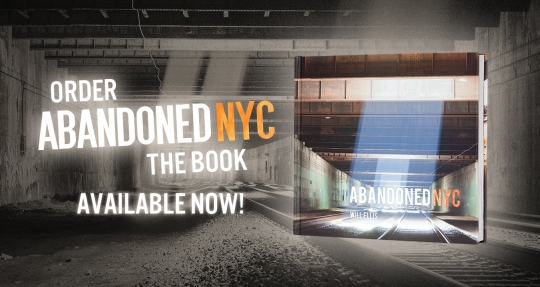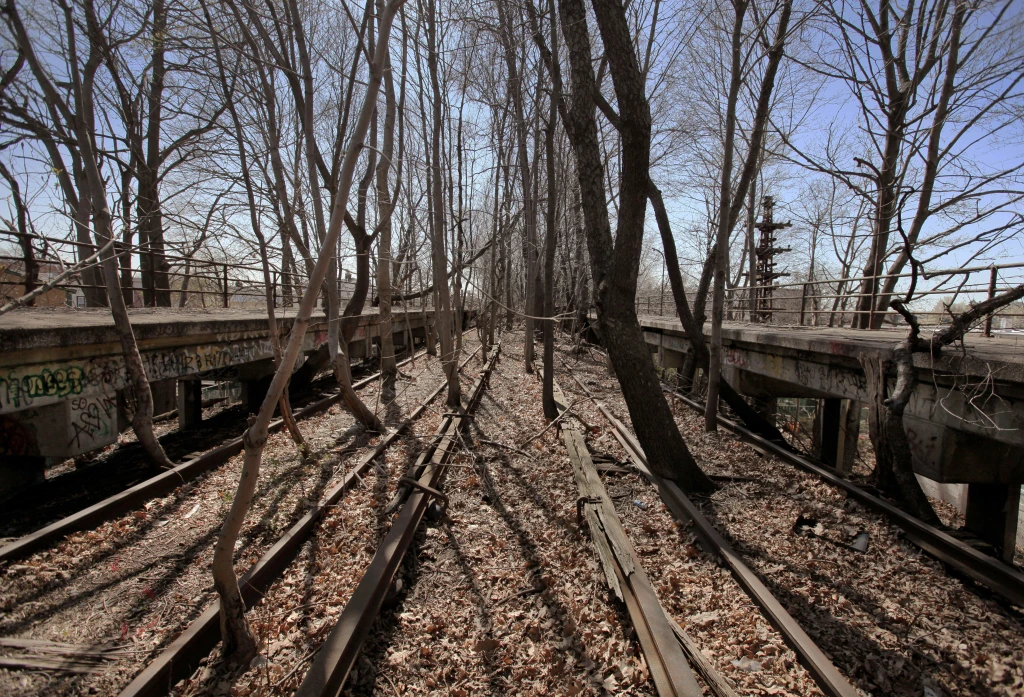AbandonedNYC
Queensway
A Baseball Graveyard in Queens

An overgrown overpass at Union Turnpike and Woodhaven Boulevard, part of the proposed Queensway project.
Abandoned for half a century, the old Rockaway Beach Branch of the Long Island Railroad is stirring debate today as opposing visions for its future emerge. Before it’s reactivated to serve beleaguered Queens commuters, or converted to the Queensway, (a linear park similar to Manhattan’s High Line), the track remains a 3.5 mile wilderness, with more than a few secrets scattered among the ruins.
At the northern edge of Forest Park, the rails terminate in a parking lot, where antiquated electrical towers have been adapted as streetlights. Across the Union Turnpike, there’s a plot of land that may be the most obscure section of the Rockaway Branch, a triangular junction wedged between a dilapidated warehouse and a complex of baseball diamonds. A well-trod path leading into the place quickly dissolves into a tangle of branches; the plant life is especially lush here, and difficult to navigate.

…just a few paces from a chain link fence that separates a packed field of cheering little leaguers.
Standing in the shadows just beyond the diamond’s edge, you’re practically invisible, in a world between worlds, and right at your feet, dozens of baseballs bloom from the earth like mushrooms…
This is the place the balls go where you can’t get them back, each a martyr and a monument to a home run that may have taken place decades ago or just this morning. Stripped of their leather casing, the older specimens reveal a second skin of frayed cotton yarn. The most ancient are unrecognizable, corrupted to a truffle-like core of black, scabrous rubber. Together, they linger in a bizarre kind of afterlife, populating the century-old tracks of a forgotten railroad—when a place is left alone, the past piles up.
Check out the gallery below for an education in baseball construction, and decay…
-Will Ellis
The Rockaway Beach Branch, Queens’ Forgotten Railroad
New York City’s narrowest jungle stretches across 3.5 miles of Central Queens, concealing the ruins of a rail line that’s been gathering rust for half a century. Abandoned by a bankrupt Long Island Railroad in 1962, the Rockaway Beach Branch is stirring debate today as opposing visions for its future emerge.
A passenger traveling on the Rockaway Beach Branch in the 1920s would board a southbound train at Whitepot Junction, pass through developing neighborhoods in Forest Hills, Glendale, Woodhaven, Richmond Hill, and Ozone Park, and traverse a burgeoning estuarine habitat called Jamaica Bay before arriving in the sandy Rockaways, then a popular vacation destination for privileged Manhattanites known as “New York’s Playground.” Today, the neighborhoods are flourishing, Jamaica Bay is losing 40 acres of marshland a year, and the isolated Rockaways are entering a stage of redevelopment.
The right-of-way was purchased by the city in the 1950s with plans to incorporate the entire line into its subway system, but the NYC Transit Authority ended up linking only the southern portion to the A train, cutting off the 3.5 mile stretch north of Rockaway Blvd. Through its 50 years of disuse, the remaining Rockaway Beach Branch has heard a stream of failed reuse and reactivation proposals as a forest has matured within its borders.
In 2005, community boards from Rego Park, Forest Hills, and other areas intersected by the line passed resolutions in favor of a linear park conversion, encouraged by the success of Manhattan’s High Line—a once abandoned rail line in Chelsea renovated into a futuristic above-ground park. According to the plan, bicycle paths and walkways would replace the derelict railroad, providing a much-needed green recreational space for the public. The Trust for Public Land is seeking private funding for a feasability study as a first step toward making the park, dubbed the “Queensway,” a reality. Beleaguered Rockaway commuters instead call for a reactivation of the line, which would provide a speedy link to Midtown Manhattan and a welcome alternative to the circuitous A-train. In response to this proposal, the MTA cites high operational and construction costs as deterrents to the project.
 Trudging through this palsied limb of the New York City transit system, it’s hard to imagine either plan coming to fruition here, a place where few people venture and fewer have a good reason to. Detritus from teenage excursions and midnight meetings collect in piles along the forgotten spur—scrapped car parts, a coil of barbed wire, scores of bottles, a forsaken shopping cart, and most memorably, a discarded cleaver.
Trudging through this palsied limb of the New York City transit system, it’s hard to imagine either plan coming to fruition here, a place where few people venture and fewer have a good reason to. Detritus from teenage excursions and midnight meetings collect in piles along the forgotten spur—scrapped car parts, a coil of barbed wire, scores of bottles, a forsaken shopping cart, and most memorably, a discarded cleaver.
In a different season, the century-old rails would be obscured by vegetation, but they’re clearly visible on this brisk February afternoon. Forty-year-old birch and oak reclaim the soil, shoving aside iron rails assembled in the 1910s. Fallen branches and debris intersect a continuous line of tracks; most electrical towers still stand, others lay mired in the overgrowth. Leaves crunching under my feet alert a chain of backyard sentinels to my presence. Aside from the dogs and the postman, little else stirs in this quiet residential community; change is coming to the Rockaway Beach Branch—but it could take another 50 years to arrive.




A jagged weapon discarded on an overpass.

A nearby substation abandoned by the LIRR.








